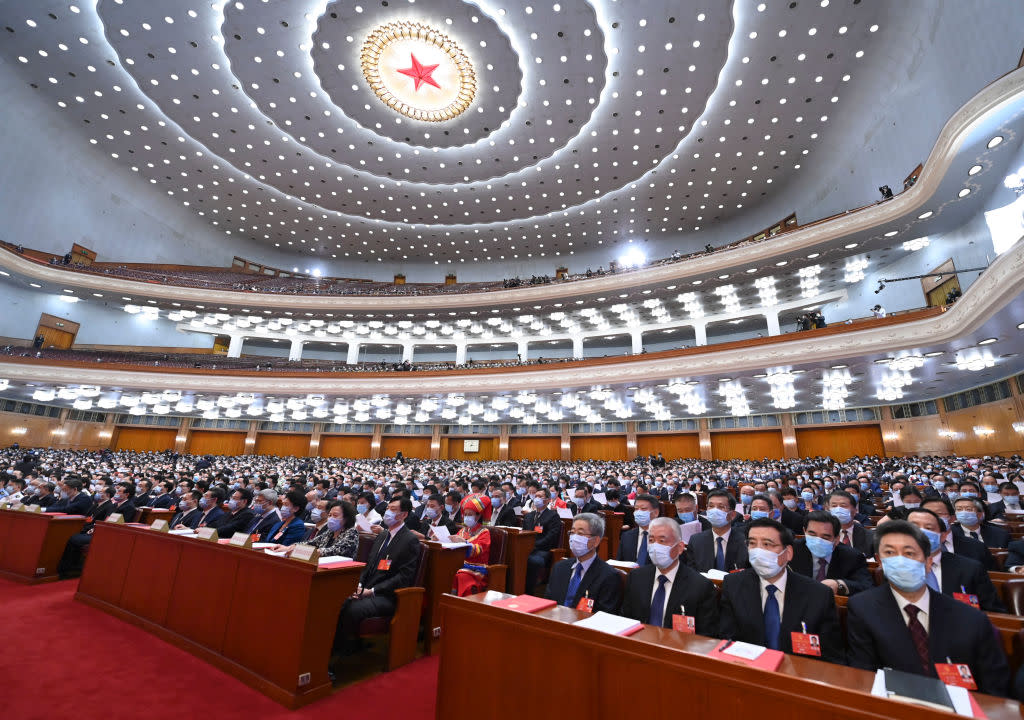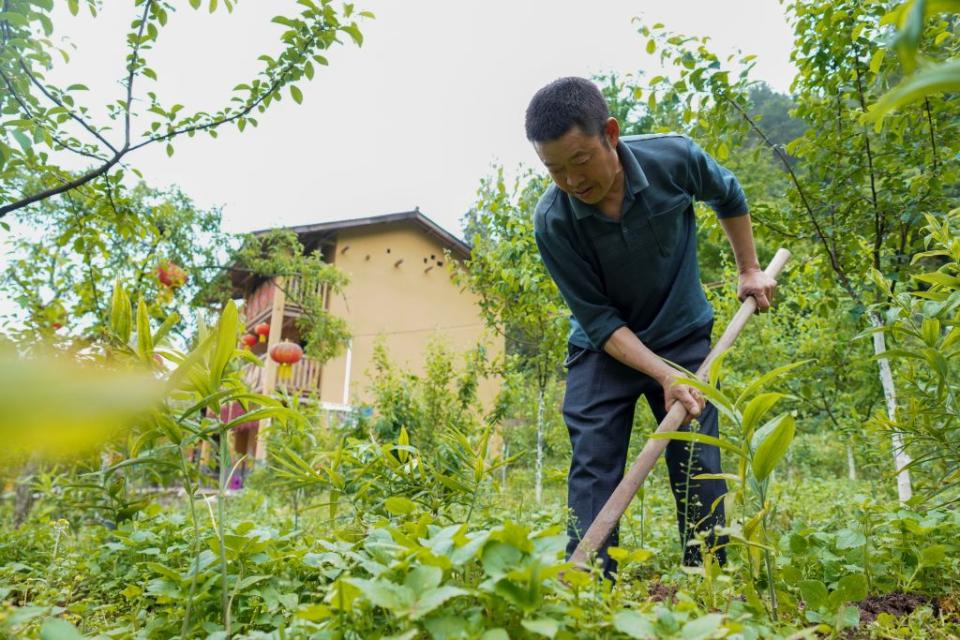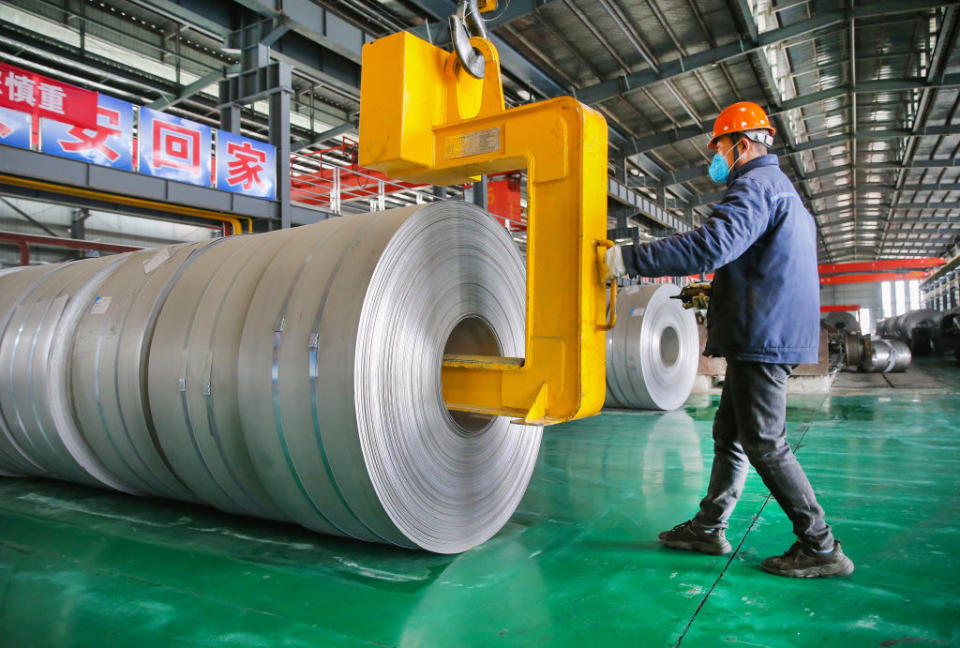China's Upcoming 'Two Sessions' Might Be Its Most Important Political Gathering in Decades

The closing meeting of the third session of the 13th National People's Congress is held at the Great Hall of the People in Beijing, capital of China, May 28, 2020. Credit - Shen Hong/Xinhua via Getty Images
On Thursday, China’s biggest annual political meetings—known collectively as the “Two Sessions”—will kick off at Beijing’s cavernous Great Hall of the People amid stringent COVID-19 restrictions. Meetings of China’s rubber-stamp legislature, the National People’s Congress (NPC), and its top political advisory body, the Chinese People’s Political Consultative Conference (CPPCC), are always important, but this year’s gatherings are especially noteworthy.
The unveiling of a new Five-Year Plan, the country’s fourteenth, mean that the 10-day policy extravaganza will be brimming with long-term initiatives. Among these will be strongman President Xi Jinping’s “2035 vision”—a grand blueprint that will build momentum as he heads toward an unprecedented third leadership term.
Within the Chinese Communist Party (CCP) “There are plenty of people who don’t want [a Xi third term] to actually happen,” grants Professor Steve Tsang, director of SOAS China Institute at the University of London. But they are not a majority, and with its centenary falling in July there will be enormous pressure on the CCP to put on an outward show of unity.
In foreign policy terms, Beijing hopes President Joe Biden will pursue more cordial ties than his predecessor, but being tough on China has bipartisan support in Washington, and the Chinese leadership will be prepared for human rights issues to remain contentious. These include the treatment of Uighurs and political tensions in Hong Kong.
The NPC is expected to pass measures to ensure there are “patriots governing Hong Kong,” following Sunday’s charging of 47 anti-Beijing activists under the former British colony’s harsh new National Security law. Hong Kong’s protest movement has sought to win greater autonomy for the territory, with some even calling for independence. But in an apparent rebuff, the CCP magazine Qiushi published on Monday a speech made by Xi last November in which he stressed the necessity of “upholding the integrity of national laws” and declared “Our country is a unitary state.”
Here are other issues that will preoccupy delegates at the Two Sessions:
China’s economic outlook
Traditionally, the first day of the NPC is when Premier Li Keqiang announces China’s GDP growth target for the coming year. However, the world’s number two economy dispensed with an official figure last year amid the pandemic, and few expect anything different this time. In a briefing note, China research firm Trivium wrote that “For Chinese leaders, it’s better to drop the target altogether than to set a target they’re not sure they can hit.”
While senior leaders have expressed confidence in China’s own economic trajectory—the country’s economy expanded 2.3% last year, according to official figures, the only major global economy to grow—uncertainly embroiling the financial health of China’s top trading partners is a worry for the world’s biggest exporter.
“The situation of China’s foreign trade this year remains grim and complex,” Minister of Commerce Wang Wentao told a press conference last week. “From the demand side, obviously there are still uncertainties about the pandemic,” he said. “In terms of the supply and industrial chains, destabilizing factors keep evolving.”
The absence of a GDP target chimes with a broader shift in policy circles from raw growth to higher quality benchmarks. Certainly, environmental protection will be front and center of the 14th Five Year Plan. Xi’s big climate change statement came at the U.N. General Assembly in the fall, when he announced that China will reach peak carbon emissions by 2030 and seek carbon neutrality by 2060. The upcoming NPC is expected to provide more indications of how this will be achieved.
Poverty alleviation in China
Last week, Xi proclaimed poverty had been officially eradicated in China. However, critics were quick to point out that poverty is a relative rather than absolute standard these days, and that China’s threshold of $1.70 per day for “extreme rural poverty” is even lower than the World Bank’s already paltry $1.90.
Still, the focus on poverty alleviation is another sign that “common prosperity” is replacing the former approach of allowing some Chinese to get rich first. Income inequality and regional disparities—particularly between booming cities and deprived rural areas—will likely be the target of rural revitalization policies unveiled at the NPC.
In November, Xi told top cadres that it was “entirely possible for China to become a high-income country by the end of the 14th five-year year plan, and to double the size of its economy or Gross Domestic Development per capita by 2035.” Key to this approach will be rural job creation, social service provision, and infrastructure upgrades to make the agriculture sector more productive and to attract more private capital to rural areas.
“People generally under-appreciate how much Xi Jinping feels that he is a Marxist,” says Tsang. “[Poverty reduction] is something he genuinely believes in, and that’s also why the state sector is going to remain important.”

China’s shrinking population
According to research published last year in The Lancet medical journal, China’s population of 1.4 billion—the world’s largest—is set to shrink to 732 million by 2100. A rapidly ageing population means a diminishing labor force. Unpopular measures like raising retirement age—unchanged in four decades at 60 for male and 55 for female government workers—must be confronted sooner rather than later.
Speculation is swirling that Beijing will further ease or abolish population controls at the NPC. But after decades of draconian family planning—not least the forced abortions and sterilizations associated with the One Child Policy—this alone won’t defuse China’s ticking demographic timebomb. Birth rates in the three rust belt northeastern provinces of Liaoning, Jilin and Heilongjiang, for example, are the lowest in China at barely half the national average of 1.69 children per woman.
The CPPCC is expected to debate incentives to encourage Chinese to have bigger families. These include extending maternity leave to six months, guaranteed paternity leave, making childcare tax deductible, subsidizing education for larger families, subsidies and tax breaks for employers who retain jobs for pregnant mothers, increased support for preschool care and the training of teachers, and financial support for growing families needing larger homes.

Boosting growth in the Chinese economy
So far, central authorities have left it to local governments to boost consumer spending, which has not matched the pandemic resilience of China’s industrial and manufacturing sectors. But more aggressive consumer support, to be unveiled at the NPC, would help boost next year’s economic outlook while easing worries over a supply glut. It would also chime with Beijing’s much-vaunted “dual circulation” strategy, which aims to boost domestic demand alongside export demand, aiming to ensure future growth and promote indigenous innovation.
“The goal is to make China’s supply chains become more resilient and not to rely on the external market for crucial technology,” says Wang Yiwei, director of the Institute of International Affairs at Renmin University in Beijing. Still, previous iterations of such strategies—primarily Made in China 2025 and China Standards 2035—prompted a U.S. backlash. China’s technological advances will have to be handled tactfully.
Following recent efforts to increase oversight of the booming fintech sector, particularly the reining in of e-commerce giants Alibaba and Tencent, analysts expect to see a recapitalizing of banks amid efforts to boost credit to small firms. Efforts to appease the U.S. financial sector—one of Beijing’s last remaining allies in Washington—may see policies to catalyze digital currency development and further open doors to foreign capital, especially in the wake of the recently inked deal with the E.U. on trade and investment.
That landmark agreement could still be blocked by European lawmakers concerned about forced labor and data protection. Those two issues may also undermine China’s efforts to join the Comprehensive and Progressive Agreement for Trans-Pacific Partnership (CPTPP)—the successor to the Obama-led TTP trade pact that Trump scrapped in his first days in office.
Wang says that it’s possible that Beijing may attempt to assuage critics by finally verifying outstanding legal protections such as the International Covenant on Civil and Political Rights, which it signed back in 1998.
“The [NPC] will do more to guarantee that China will protect legal and civil rights,” he says. “Because [data privacy and labor rights] are also obstacles for China to join high quality negotiations for trade and investment, not just with Europe, but maybe the CPTPP as well.”

